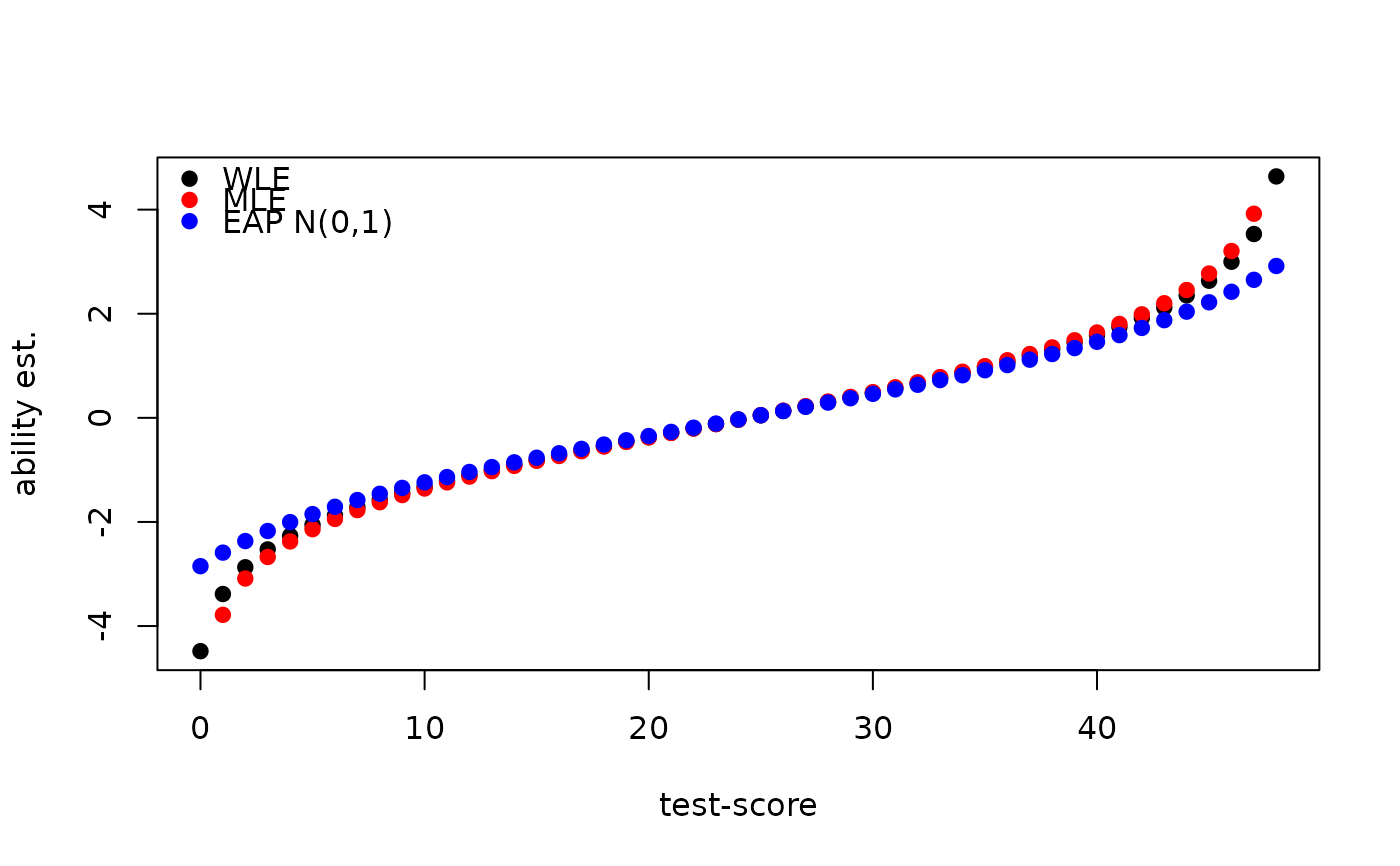Computes estimates of ability for persons or for booklet scores
ability(
dataSrc,
parms,
predicate = NULL,
method = c("MLE", "EAP", "WLE"),
prior = c("normal", "Jeffreys"),
parms_draw = c("sample", "average"),
mu = 0,
sigma = 4,
merge_within_persons = FALSE
)
ability_tables(
parms,
design = NULL,
method = c("MLE", "EAP", "WLE"),
prior = c("normal", "Jeffreys"),
parms_draw = c("sample", "average"),
mu = 0,
sigma = 4
)Arguments
- dataSrc
a connection to a dexter database, a matrix, or a data.frame with columns: person_id, item_id, item_score
- parms
object produced by
fit_enormor a data.frame with columns item_id, item_score and, beta- predicate
An optional expression to subset data, if NULL all data is used
- method
Maximum Likelihood (MLE), Expected A posteriori (EAP) or Weighted Likelihood (WLE)
- prior
If an EAP estimate is produced one can choose a normal prior or Jeffreys prior; i.e., a prior proportional to the square root of test information.
- parms_draw
When parms is Bayesian, parms_draw can be the index of the posterior sample of the item parameters that will be used for generating abilities. If parms_draw='sample' ability estimates are estimated over all draws and averaged. Rubin's rule is used to combine the imputation variance and sampling variance. If parms_draw='average', the posterior mean of the item parameters is used.
- mu
Mean of the normal prior
- sigma
Standard deviation of the normal prior
- merge_within_persons
for persons who were administered multiple booklets, whether to provide just one ability value (TRUE) or one per booklet(FALSE)
- design
A data.frame with columns item_id and optionally booklet_id. If the column booklet_id is not included, the score transformation table will be based on all items found in the design. If design is NULL and parms is an enorm fit object the score transformation table will be computed based on the test design that was used to fit the items.
Value
- ability
a data.frame with columns: booklet_id, person_id, booklet_score, theta and optionally se (standard error)
- ability_tables
a data.frame with columns: booklet_id, booklet_score, theta and optionally se (standard error)
Details
MLE estimates of ability will produce -Inf and Inf estimates for the minimum (=0) and the maximum score on a booklet. If this is undesirable, we advise to use WLE. The WLE was proposed by Warm (1989) to reduce bias in the MLE and is also known as the Warm estimator.
References
Warm, T. A. (1989). Weighted likelihood estimation of ability in item response theory. Psychometrika, 54(3), 427-450.
Examples
db = start_new_project(verbAggrRules, ":memory:")
add_booklet(db, verbAggrData, "agg")
#> no column `person_id` provided, automatically generating unique person id's
#> $items
#> [1] "S1DoCurse" "S1DoScold" "S1DoShout" "S1WantCurse" "S1WantScold"
#> [6] "S1WantShout" "S2DoCurse" "S2DoScold" "S2DoShout" "S2WantCurse"
#> [11] "S2WantScold" "S2WantShout" "S3DoCurse" "S3DoScold" "S3DoShout"
#> [16] "S3WantCurse" "S3WantScold" "S3WantShout" "S4DoCurse" "S4DoScold"
#> [21] "S4DoShout" "S4WantCurse" "S4WantScold" "S4WantShout"
#>
#> $person_properties
#> character(0)
#>
#> $columns_ignored
#> [1] "gender" "anger"
#>
f = fit_enorm(db)
mle = ability_tables(f, method="MLE")
eap = ability_tables(f, method="EAP", mu=0, sigma=1)
wle = ability_tables(f, method="WLE")
plot(wle$booklet_score, wle$theta, xlab="test-score", ylab="ability est.", pch=19)
points(mle$booklet_score, mle$theta, col="red", pch=19,)
points(eap$booklet_score, eap$theta, col="blue", pch=19)
legend("topleft", legend = c("WLE", "MLE", "EAP N(0,1)"),
col = c("black", "red", "blue"), bty = "n",pch = 19)
 close_project(db)
close_project(db)